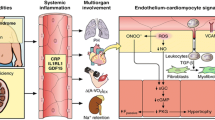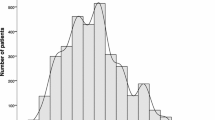Abstract
Aims
Heart failure (HF) guidelines recommend treating all patients with HF and reduced ejection fraction (HFrEF) with quadruple therapy, although they do not establish how to start it. This study aimed to evaluate the implementation of these recommendations, analyzing the efficacy and safety of the different therapeutic schedules.
Methods and results
Prospective, observational, and multicenter registry that evaluated the treatment initiated in patients with newly diagnosed HFrEF and its evolution at 3 months. Clinical and analytical data were collected, as well as adverse reactions and events during follow-up.
Five hundred and thirty-three patients were included, selecting four hundred and ninety-seven, aged 65.5 ± 12.9 years (72% male). The most frequent etiologies were ischemic (25.5%) and idiopathic (21.1%), with a left ventricular ejection fraction of 28.7 ± 7.4%. Quadruple therapy was started in 314 (63.2%) patients, triple in 120 (24.1%), and double in 63 (12.7%). Follow-up was 112 days [IQI 91; 154], with 10 (2%) patients dying. At 3 months, 78.5% had quadruple therapy (p < 0.001). There were no differences in achieving maximum doses or reducing or withdrawing drugs (< 6%) depending on the starting scheme. Twenty-seven (5.7%) patients had any emergency room visits or admission for HF, less frequent in those with quadruple therapy (p = 0.02).
Conclusion
It is possible to achieve quadruple therapy in patients with newly diagnosed HFrEF early. This strategy makes it possible to reduce admissions and visits to the emergency room for HF without associating a more significant reduction or withdrawal of drugs or significant difficulty in achieving the target doses.
Graphical abstract



Similar content being viewed by others
Data availability
The datasets generated and analyzed during the current study are available from the corresponding author on reasonable request.
Abbreviations
- ARNI:
-
Dual inhibitors of type II angiotensin receptor and neprilysin
- BB:
-
Beta-blockers
- BP:
-
Blood pressure
- CKD-EPI:
-
Chronic kidney disease epidemiology collaboration formula
- CRT:
-
Cardiac resynchronization therapy
- CV:
-
Cardiovascular
- GFR:
-
Glomerular filtration rate
- HF:
-
Heart failure
- HFrEF:
-
Heart failure with a reduced left ventricular ejection fraction
- HFpEF:
-
Heart failure with a preserved left ventricular ejection fraction
- HR:
-
Heart rate
- ICD:
-
Implantd cardiac desfibrilator
- LVEF:
-
Left ventricular ejection fraction
- MRA:
-
Mineralocorticoid receptor antagonists
- NTproBNP:
-
Amino-terminal pro-brain natriuretic peptide type B portion
- NYHA:
-
New York Heart Association
- OR:
-
Odds ratio
- RAASi:
-
Renin–angiotensin–aldosterone system inhibitors
- SGLT2i:
-
Sodium and glucose cotransporter type 2 inhibitors
- SBP:
-
Systolic blood pressure
- TAPSE:
-
Tricuspid annulus plane systolic displacement
References
Conrad N, Judge A, Tran J et al (2018) Temporal trends and patterns in heart failure incidence: a population-based study of 4 million individuals. Lancet (London, England) 391:572–580
Martínez Santos P, Bover Freire R, Esteban Fernández A et al (2019) In-hospital mortality and readmissions for heart failure in Spain. A study of index episodes and 30-day and 1-year cardiac readmissions. Rev Esp Cardiol (Engl Ed). 72:998–1004
Gómez-Otero I, Ferrero-Gregori A, Varela Román A et al (2017) Mid-range ejection fraction does not permit risk stratification among patients hospitalized for heart failure. Rev Esp Cardiol (Engl Ed) 70:338–346
Anguita Gámez M, Esteban Fernández A, García Márquez M, del Prado N, Elola Somoza FJ, Anguita Sanchez M (2022) Age and stabilization of admissions for heart failure in Spain (2006–2019). The beginning of the end of the “epidemic”? Rev Esp Cardiol (Engl Ed). 76(4):272–274
Savarese G, Lund LH (2017) Global public health burden of heart failure. Card Fail Rev 3:7
Zannad F, Ferreira JP, Pocock SJ et al (2020) SGLT2 inhibitors in patients with heart failure with reduced ejection fraction: a meta-analysis of the EMPEROR-reduced and DAPA-HF trials. Lancet (London, England) 396:819–829
McMurray JJV, Packer M, Desai AS et al (2014) Angiotensin-neprilysin inhibition versus enalapril in heart failure. N Engl J Med 371:993–1004
Tromp J, Ouwerkerk W, van Veldhuisen DJ et al (2022) A Systematic review and network meta-analysis of pharmacological treatment of heart failure with reduced ejection fraction. JACC Heart Fail 10:73–84
Heidenreich PA, Bozkurt B, Aguilar D et al (2022) 2022 AHA/ACC/HFSA guideline for the management of heart failure: a report of the American college of cardiology/american heart association joint committee on clinical practice guidelines. J Am Coll Cardiol 79:e263–e421
McDonagh TA, Metra M, Adamo M et al (2021) 2021 ESC Guidelines for the diagnosis and treatment of acute and chronic heart failure. Eur Heart J 42:3599–3726
Rosano GMC, Moura B, Metra M et al (2021) Patient profiling in heart failure for tailoring medical therapy. A consensus document of the heart failure association of the European Society of Cardiology. Eur J Heart Fail. 23:872–881
Anguita Sánchez M, Lambert Rodríguez JL, Bover Freire R et al (2016) Classification and quality standards of heart failure units: scientific consensus of the Spanish Society of Cardiology. Rev Esp Cardiol (Engl Ed) 69:940–950
Lang RM, Badano LP, Mor-Avi V et al (2015) Recommendations for cardiac chamber quantification by echocardiography in adults: an update from the American Society of Echocardiography and the European Association of Cardiovascular Imaging. Eur Hear J Cardiovasc Imaging 16:233–271
Von Elm E, Altman DG, Egger M, Pocock SJ, Gøtzsche PC, Vandenbroucke JP (2007) The strengthening the reporting of observational studies in epidemiology (STROBE) statement: guidelines for reporting observational studies. Ann Intern Med 147:573–577
McMurray JJV, Packer M (2021) How should we sequence the treatments for heart failure and a reduced ejection fraction?: a redefinition of evidence-based medicine. Circulation 143:875–877
Miller RJH, Howlett JG, Fine NM (2021) A novel approach to medical management of heart failure with reduced ejection fraction. Can J Cardiol 37:632–643
Velazquez EJ, Morrow DA, DeVore AD et al (2019) Angiotensin-neprilysin inhibition in acute decompensated heart failure. N Engl J Med 380:539–548
Kapelios CJ, Laroche C, Crespo-Leiro MG et al (2020) Association between loop diuretic dose changes and outcomes in chronic heart failure: observations from the ESC-EORP heart failure long-term registry. Eur J Heart Fail 22:1424–1437
Beldhuis IE, Lam CSP, Testani JM et al (2022) Evidence-based medical therapy in patients with heart failure with reduced ejection fraction and chronic kidney disease. Circulation 145:693–712
Anker SD, Butler J, Filippatos G et al (2021) Effect of empagliflozin on cardiovascular and renal outcomes in patients with heart failure by baseline diabetes status: results from the EMPEROR-reduced trial. Circulation 143:337–349
Esteban-Fernández A, Ortiz Cortés C, López-Fernández S et al (2022) Experience with the potassium binder patiromer in hyperkalaemia management in heart failure patients in real life. ESC Hear Fail 9(5):3071–3078
Kotecha D, Holmes J, Krum H et al (2014) Efficacy of β blockers in patients with heart failure plus atrial fibrillation: an individual-patient data meta-analysis. Lancet (London, England) 384:2235–2243
Böhm M, Swedberg K, Komajda M et al (2010) Heart rate as a risk factor in chronic heart failure (SHIFT): the association between heart rate and outcomes in a randomised placebo-controlled trial. Lancet (London, England) 376:886–894
Tymińska A, Ozierański K, Wawrzacz M et al (2022) Heart rate control and its predictors in patients with heart failure and sinus rhythm. Data from the European Society of Cardiology long-term registry. Cardiol J. https://doi.org/10.5603/CJ.a2022.0076
Vardeny O, Claggett B, Kachadourian J et al (2018) Incidence, predictors, and outcomes associated with hypotensive episodes among heart failure patients receiving sacubitril/valsartan or enalapril: the PARADIGM-HF trial (prospective comparison of angiotensin receptor neprilysin inhibitor with angiotensin-converting enzyme inhibitor to determine impact on global mortality and morbidity in heart failure). Circ Heart Fail 11(4):e004745
Mebazaa A, Davison B, Chioncel O et al (2022) Safety, tolerability and efficacy of up-titration of guideline-directed medical therapies for acute heart failure (STRONG-HF): a multinational, open-label, randomised, trial. Lancet (London, England). 400(10367):1938–1952
Oyanguren J, Garcia-Garrido L, Nebot-Margalef M et al (2021) Noninferiority of heart failure nurse titration versus heart failure cardiologist titration ETIFIC multicenter randomized trial. Rev Esp Cardiol (Engl Ed) 74:533–543
Crespo-Leiro MG, Segovia-Cubero J, González-Costello J et al (2015) Adherence to the ESC heart failure treatment guidelines in spain: ESC heart failure long-term registry. Rev Esp Cardiol (Engl Ed) 68:785–793
Acknowledgements
List of contributors to the TIDY-HF registry: Xabier Arana-Achaga, Francisco José Bermúdez Jiménez, Marta Cobo Marcos, Concepción Cruzado Álvarez, Juan F. Delgado Jiménez, Víctor Donoso Trenado, Inmaculada Fernández Rozas, Aleix Fort, Belén García, María Dolores García-Cosío Carmena, Clara Jiménez Rubio, Laura Jordán Martínez, Bernardo Lanza Reynolds, Juan Carlos López-Azor, Raquel López Vilella, Ainara Lozano Bahamonde, Irene Marco Clement, Elisabet Mena Sabastia, María Molina Villar, Julio Nuñez Villota, Pedro Agustín Pájaro Merino, Alejandro Pérez Cabeza, Montserrat Puga Martínez, Ainhoa Robles Mezcua, Ester Sánchez Corral, Enrique Sánchez Muñoz, José María Segura Aumente, Estefanía Torrecilla and Iñaki Villanueva Benito.
Funding
This project was supported by a grant for Heart Failure Research projects from the Heart Failure Association of the Spanish Society of Cardiology (SECAINC-INV-ICC 21/003). An unconditional grant from Novartis and an unconditional grant from Boehringer-Ingelheim provided additional support.
Author information
Authors and Affiliations
Consortia
Contributions
Study design: AE-F, IGO. Data collection: all authors. Data review and statistical analysis: AE-F, IGO. Manuscript drafting: AE-F, IGO. Review, editing, and acceptance of the manuscript: all authors.
Corresponding author
Ethics declarations
Conflict of interest
AE-F has received scientific speaking fees from Novartis, Bayer, Vifor, Fresenius, and Boehringer-Ingelheim. IGO has received funding or fees from Pfizer, Novartis, Rovi, Vifor, Orion, and Boheringer-Ingelheim. JJB reports consulting and speaking fees from Almirall, AstraZeneca, ArrhytNeT, Bayer, Boehringer-Ingelheim, Boston Scientific, Daiichi Sankyo, Esteve, Impulse Dynamics, Orion Pharma, Novartis, Rovi, Servier, and Vifor. The other authors declare no conflict of interest with this article.
Additional information
The complete details of author involved in TIDY-HF investigators are given in acknowledgements.
Supplementary Information
Below is the link to the electronic supplementary material.


Rights and permissions
Springer Nature or its licensor (e.g. a society or other partner) holds exclusive rights to this article under a publishing agreement with the author(s) or other rightsholder(s); author self-archiving of the accepted manuscript version of this article is solely governed by the terms of such publishing agreement and applicable law.
About this article
Cite this article
Esteban-Fernández, A., Gómez-Otero, I., López-Fernández, S. et al. Influence of the medical treatment schedule in new diagnoses patients with heart failure and reduced ejection fraction. Clin Res Cardiol (2023). https://doi.org/10.1007/s00392-023-02241-0
Received:
Accepted:
Published:
DOI: https://doi.org/10.1007/s00392-023-02241-0




